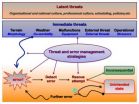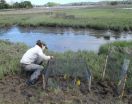(Press-News.org) This news release is available in Spanish.
A new method of monitoring identifies what information will be relevant on social networks up to two months in advance. This may help predict social movements, consumer reactions or possible outbreaks of epidemics, according to a study in the Universidad Carlos III of Madrid (UC3M) is participating.
The aim of the research, on which scientists from the Universidad Autónoma of Madrid, the NICTA of Australia, and the American universities Yale and the University of California-San Diego have also collaborated, was to test what is known as the "sensors hypothesis" on the social networks: Is it possible to find a group of people (sentinels or sensors) with a special position that would allow the information that "goes viral" globally on the internet to be monitored? "If we could do that, we would be able to predict that viral spread, which would allow us to better understand social mobilization, debates regarding opinions, health, etc., and to determine how they become global," explains one of the researchers, Esteban Moro Egido, of the Interdisciplinary Complex Systems Group at UC3M (Grupo Interdisciplinar de Sistemas Complejos).
To do this, the scientists made use of one of the properties of the social networks that can also be observed in Twitter; it is known as "the friendship paradox": your friends have, on average, more friends than you. In the case of Twitter, after analyzing a sample of data from 40 million users and 15 billion followers in 2009, the researchers were able to show that each user had an average of 25 followers, who in turn had an average of 422 followers, that is, almost twenty times as many. "This means that a person's followers have a role in a social network that makes them very relevant when it comes to spreading or receiving information," explains another of the researchers, Manuel García Herranz, of the Computer Engineering Department at the Universidad Autónoma of Madrid.
What they have done in this study, which has been published in the journal PLoS ONE, is to randomly select a group of users and take some of their followers as the sensor group. And what they have found out is that those "sensor-friends" play a more important role than what was previously believed, because they receive information long before the previously chosen users. "We were really surprised. We thought the method would give us a few hours early warning, but instead it gave us several days, and sometimes even weeks or months," says co-senior author of the authors, James Fowler, professor of medical genetics and political science at the University of California-San Diego (USA). For example, the sensor model predicted the "viral" rise of the hashtag "#Obamacare" as a Twitter trend, detecting it two months before it peaked on Twitter, and three months before it reached the highest number of Google searches with that name.
Simple and effective
In general, this new method turns out to be very simple and effective for monitoring social networks, according to its creators. Data from just 50,000 Twitter is enough to achieve these levels of prediction and to know what will "go viral" across the entire Internet. It can be used in real time, about different topics, in different languages and geographical areas, thus allowing for different contexts to be covered: discovering new opinions in a political debate, predicting social movements, obtaining previous knowledge of consumers' reactions to new products, or analyzing how messages regarding certain illnesses or epidemics are spread in the public health arena.
This system has certain limitations. It cannot predict how information associated with a particular event, such as a football match, or daily news or natural disasters is going to spread "virally", the scientists warn. However, there are other types of news that it is able to predict, such as social movements (the 15M in Madrid) or ideas that have been moving around the web for a while on a small scale and then later reach the general public. "We found that monitoring social media in this manner offers a whole new way of monitoring the global spread of information about all sorts of topics," comments another one of the researchers, Nicholas Christakis, co-director of the Yale Institute for Network Science, USA. This is undoubtedly a new way of predicting the future by analyzing the data that circulates on the social networks.
INFORMATION:
Further information:
Garcia-Herranz M, Moro E, Cebrian M, Christakis NA, Fowler JH (2014). Using Friends as Sensors to Detect Global-Scale Contagious Outbreaks. PLoS ONE 9(4): e92413. Published 09 Apr 2014. doi:10.1371/journal.pone.0092413
Watch video:
https://www.youtube.com/watch?v=KlfmZNzZXVg
A system detects global trends in social networks 2 months in advance
Works using just 50,000 Twitter accounts
2014-04-28
ELSE PRESS RELEASES FROM THIS DATE:
Researchers identify potential new strategy to treat ovarian cancer
2014-04-28
Scientists studying cancerous tumour tissues in a laboratory believe they have identified a potential new strategy to treat ovarian cancer – which affects around 7,000 women in the UK each year.
Recently developed drugs have increased patient survival rates by targeting a tumour's blood vessels that supply essential nutrients and oxygen to cancer cells.
However, many patients go on to develop resistance to these therapies and grow new blood vessels that spread the cancer again.
A team from The University of Manchester – part of the Manchester Cancer Research Centre ...
Genetic disorder causing strokes and vascular inflammation in children has been discovered
2014-04-28
Academy research fellows from University of Turku (Finland), Andrey and Anton Zavialov, and a team of researches from the National Institutes of Health (NIH), USA, discovered that inherited mutations in a blood enzyme called ADA2 cause a syndrome of sporadic fevers, skin rashes and recurring strokes, beginning early in childhood. The novel genetic disorder was called deficiency of ADA2, or DADA2.
The disease has a broad range of symptoms and its severity varies significantly, which represent a problem for making an accurate diagnosis. Since the cause of the disease is ...
Australian marine reserves provide safe passageway for endangered species
2014-04-28
The value of Australia's newly established network of marine parks has been highlighted by an international project that used satellites to track the vulnerable flatback sea turtle. The findings are published in Springer's journal Marine Biology. In the study, researchers from Deakin University (Australia), Swansea University (U.K.) and Pendoley Environmental consultancy (Australia) used advanced satellite tracking systems to record the passage of more than 70 flatbacks off the north-west Australian coastline.
A high value migratory corridor, more than 1,000 kilometres ...
Flexible battery, no lithium required
2014-04-28
HOUSTON – (April 28, 2014) – A Rice University laboratory has flexible, portable and wearable electronics in its sights with the creation of a thin film for energy storage.
Rice chemist James Tour and his colleagues have developed a flexible material with nanoporous nickel-fluoride electrodes layered around a solid electrolyte to deliver battery-like supercapacitor performance that combines the best qualities of a high-energy battery and a high-powered supercapacitor without the lithium found in commercial batteries today.
The new work by the Rice lab of chemist James ...
Applying lessons from NASA helps manage threats and errors in pediatric cardiac surgery
2014-04-28
Toronto, ON, Canada, April 28, 2014 – All high-stakes industries that function at very high "6-sigma" safety levels have a pre-occupation with human error. The aviation industry epitomizes this concept; during the 1970s NASA and aviation researchers realized that humans are the least reliable resource in the cockpit. Subsequent research into >30,000 flights has confirmed that human error is inevitable, ubiquitous, and therefore needs to be understood and managed. Mismanaged error leads to cycles of further error and unintended states, with consequent loss of safety margins. ...
Complications from kidney stone treatments are common and costly
2014-04-28
DURHAM, N.C. – Despite their overall low risk, procedures to treat kidney stones lead to complications that require hospitalization or emergency care for one in seven patients, according to researchers at Duke Medicine.
These complications are costly. Patients who have an unplanned visit face an average cost of nearly $30,000, depending on the type of procedure and the subsequent care.
"Our findings provide a good starting point to understand why these complications are happening and how they can be prevented, because the costs to patients who suffer complications ...
Research shows strategic thinking strengthens intellectual capacity
2014-04-28
Strategy-based cognitive training has the potential to enhance cognitive performance and spill over to real-life benefit according to a data-driven perspective article by the Center for BrainHealth at The University of Texas at Dallas published in the open-access journal Frontiers in Systems Neuroscience. The research-based perspective highlights cognitive, neural and real-life changes measured in randomized clinical trials that compared a gist-reasoning strategy-training program to memory training in populations ranging from teenagers to healthy older adults, individuals ...
Weekly emails to hospital C-suite halt 2 decades of superbug outbreak
2014-04-28
Washington, DC, April 28, 2014 – Efforts to reduce and stop the spread of infections caused by a highly resistant organism, carbapenem-resistant Acinetobacter baumannii, at a large Florida hospital proved ineffective until they added another weapon – weekly emails from the medical director of Infection Control to hospital leadership, according to a study published in the May issue of the American Journal of Infection Control, the official publication of the Association for Professionals in Infection Control and Epidemiology (APIC).
When the hospital added the step of ...
Studies affirm crabs killing Northeast saltmarshes
2014-04-28
PROVIDENCE, R.I. [Brown University] — A marathon summer of field work by Mark Bertness, professor of ecology and evolutionary biology, and a squadron of students may finally help settle the heated debate about what's killing the coastal saltmarshes of southern New England and Long Island. The group's work has yielded two new papers that offer clear evidence of the cause.
In one paper, published March 20 in the journal PLoS ONE, they provide the results of numerous measurements at 14 sites around Rhode Island's Narragansett Bay. They sought correlations between the exent ...
The power of protein at breakfast; higher amounts may deliver more benefits
2014-04-28
CHICAGO, Apr. 28, 2014 –Many consumers are aware they should make protein a priority at breakfast, but it may be equally important for them to choose an optimal amount of protein to maximize its benefits, suggests new research presented at the American Society for Nutrition's Experimental Biology conference this week. Researchers found that when comparing common breakfasts with varying amounts of protein, a commercially prepared turkey-sausage and egg bowl, cereal and milk, and pancakes with syrup, choosing the higher-protein commercially prepared turkey-sausage and egg ...
LAST 30 PRESS RELEASES:
School meals could unlock major gains for human and planetary health
Menopause hormone therapy does not appear to impact dementia risk
Signature patterns of brain activity may help predict recovery from traumatic brain injury
Dresden study uncovers new key mechanism in cancer cells
New species are now being discovered faster than ever before, study suggests
Cannabis-based products show limited short-term benefit for chronic pain, with increased risk of adverse effects
Cannabis products with more THC slightly reduce pain but cause more side effects
Clearing the brain of aging cells could aid epilepsy and reduce seizures
Brain injuries linked with potential risk of suicide, new study finds
New technique lights up where drugs go in the body, cell by cell
New study finds movement of fishing fleets can reveal shifts in marine ecosystems
Embargoed: New evidence points to potential treatment for vascular dementia
Study uncovers disrupted brain balance in alcohol dependence
Working in groups can help Republicans and Democrats agree on controversial content moderation online
Structural findings reveal how distinct GPCR ligands create different levels of activation
Anything-goes “anyons” may be at the root of surprising quantum experiments
UC review: Maximizing workplace opportunity for veterans
From generation to complex control: Metasurfaces make perfect vortex beams "within reach"
Thin-film lithium niobate-based detector: recent advances and perspectives
Exploring why some people may tend to persistently make bad choices
How cells balance their protein levels
Nirsevimab vs RSVpreF vaccine for RSV–related hospitalization in newborns
Effectiveness and impact of maternal RSV immunization and nirsevimab on medically attended RSV in US children
AI gives scientists a boost, but at the cost of too many mediocre papers
Next-generation vision model maps tree growth at sub-meter precision
Genes aren’t destiny for inherited blindness, study shows
MIT study: High-fat diets make liver cells more likely to become cancerous
Exposure to multiple fine particulate matter components and incident depression in the US Medicare population
Risk of burdensome health care spending over time in the US
Nirsevimab against hospitalizations and emergency department visits for lower respiratory tract infection in infants
[Press-News.org] A system detects global trends in social networks 2 months in advanceWorks using just 50,000 Twitter accounts


